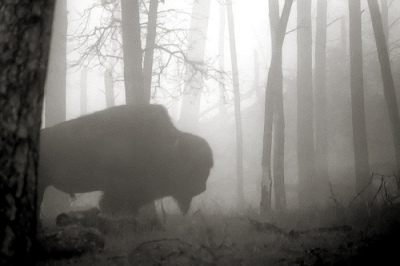BUFFALO
April 22, 2008
by: jovial_cynic
by: jovial_cynic

image: Buffalo in the mist (cc) Daveybot
I've been feeling restless lately. I think it's because of the clash between the season and the weather; I want it to be a little warmer and spring-like, so I can get my garden going and so I can have more outdoor time with my kids. The snow from the weekend was quite unwelcome.
Anyhow, this lightened my mood:
Buffalo buffalo Buffalo buffalo buffalo buffalo Buffalo buffalo.
The above is 100% grammatically correct in the english language.
From the Wikipedia:
Sentence construction
The sentence is unpunctuated and uses three different readings of the word "buffalo". In order of their first use, these are
* c. The city of Buffalo, New York (or any other place named "Buffalo"), which is used as an adjective in the sentence and is followed by the animal;
* a. The animal buffalo, in the plural (equivalent to "buffaloes"), in order to avoid articles (a noun);
* v. The verb "buffalo" meaning to bully, confuse, deceive, or intimidate.
Marking each "buffalo" with its use as shown above gives
Buffalo(c) buffalo(a) Buffalo(c) buffalo(a) buffalo(v) buffalo(v) Buffalo(c) buffalo(a).
Thus, the sentence when parsed reads as a description of the pecking order in the social hierarchy of buffaloes living in Buffalo:
[Those] (Buffalo buffalo) [whom] (Buffalo buffalo buffalo) buffalo (Buffalo buffalo).
[Those] buffalo(es) from Buffalo [that are intimidated by] buffalo(es) from Buffalo intimidate buffalo(es) from Buffalo.
Bison from Buffalo, New York who are intimidated by other bison in their community also happen to intimidate other bison in their community.
It may be revealing to read the sentence replacing all instances of the animal buffalo with "people" and the verb buffalo with "intimidate". The sentence then reads
"Buffalo people [whom] Buffalo people intimidate [also happen to] intimidate Buffalo people."

